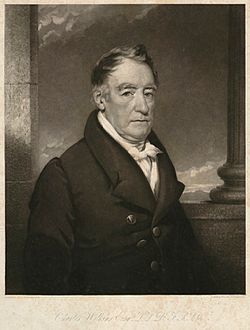Charles Wilkins facts for kids
Quick facts for kids
Sir
Charles Wilkins
KH FRS
|
|
|---|---|

Charles Wilkins, in an mezzotint engraving by John Sartain, after a painting by James Godsell Middleton. Published in 1830.
|
|
| Born |
Charles Wilkins
1749 |
| Died | 13 May 1836 (aged 86–87) |
| Nationality | English |
| Citizenship | England |
| Occupation | Orientalist, typographer |
Sir Charles Wilkins (1749 – 13 May 1836) was an amazing English scholar. He was a pioneer in studying Eastern cultures, known as an Orientalist. He also designed typefaces for printing. He is most famous for being the first person to translate the Bhagavad Gita into English.
Wilkins was a founding member of The Asiatic Society. He also helped create one of the first Bengali typefaces. He was the first to use the term Hinduism to describe the many cultures and mythologies in India. In 1788, Wilkins became a member of the Royal Society.
Contents
Early Life and Work in India
Charles Wilkins was born in 1749 in Frome, England. He trained to be a printer. In 1770, he traveled to India to work for the British East India Company. He quickly learned Persian and Bengali.
Creating New Typefaces
Wilkins personally created the first type for printing Bengali. He published the first book printed using this new type. This earned him the nickname "the Caxton of India." William Caxton was famous for introducing the printing press to England. Wilkins also designed type for books printed in Persian.
In 1781, he became a translator for the Company. He also managed the Company's printing press. He successfully translated an old royal inscription written in Kutila characters. These characters were previously impossible to read.
Founding the Asiatic Society
In 1784, Wilkins helped William Jones start the Asiatic Society of Bengal. This society was important for studying Asian history and culture.
Studying Ancient Texts
Wilkins moved to Varanasi in India. There, he studied Sanskrit with a Brahmin scholar named Kalinatha. During this time, he began translating the ancient Indian epic, the Mahabharata. The governor of British India, Warren Hastings, strongly supported his work.
Translating the Bhagavad Gita
Wilkins never finished the full translation of the Mahabharata. However, he published parts of it. His most important work was his translation of the Bhagavad Gita. It was published in 1785 as Bhagvat-geeta, or Dialogues of Krishna and Arjun.
In his introduction, Wilkins suggested that the Gita promoted a single God. He believed it could move Hinduism away from the idea of many gods.
Exploring Other Religions
Wilkins was very interested in learning about different religions. He stayed in India for 16 years, from 1770 to 1786. He visited holy places of various faiths to understand their customs.
During a trip to Varanasi, he stopped at Patna. He visited Patna Sahib Gurudwara, which is the birthplace of Guru Gobind Singh Ji. He wrote about this visit in an account called 'Sikhs and their College at Patna'.
Deciphering Ancient Scripts
In 1785, Charles Wilkins also deciphered ancient inscriptions from the 6th century CE. These were written in the Brahmi script. He published a correct translation of the Gopika Cave Inscription. This inscription was written by the Maukhari king Anantavarman. Wilkins used similarities with later Indian scripts to help him.
Return to England and Later Achievements
When Warren Hastings left India, Wilkins lost his main supporter. He returned to England in 1786 and married Elizabeth Keeble.
Impact of His Translations
His translation of the Bhagavad Gita was soon translated into French (1787) and German (1802). It greatly influenced Romantic literature and how Europeans understood Hindu philosophy. The artist William Blake even created a picture called The Bramins in 1809. It showed Wilkins and Brahmin scholars working on the translation.
In 1787, Wilkins published another translation. It was The Heetopades of Veeshnoo-Sarma. This book contained fables with moral lessons.
New Roles and Honors
In 1788, he became a fellow of the Royal Society. In 1800, he was asked to be the first director of the India House Library. This library later became the famous 'India Office Library'. In 1801, he became the librarian for the East India Company. He also became an examiner at Haileybury in 1805.
During these years, he worked on creating a font for Devanagari. This is the script used for Sanskrit and Hindi. In 1808, he published his Grammar of the Sanskrita Language.
In 1833, King George IV gave him the badge of the Royal Guelphic Order. He was also knighted for his important contributions to Oriental scholarship. Sir Charles Wilkins passed away in London at the age of 86.
Other Publications
Besides his own translations, Wilkins also helped publish other important works. He released a new edition of John Richardson's Persian and Arabic dictionary in 1810. He also created a list of manuscripts collected by Sir William Jones.
See also
- Royal Society—Wilkins was elected to membership in the Society in 1788. Those signing that nomination letter were: James Rennell, William Marsden, Charles Blagden, Alexander Dalrymple, Samuel Harper, George Staunton, Thomas Astle.
Images for kids
-
Decipherment of the Gopika Cave Inscription (6th century CE, Late Brahmi), with the original script in Late Brahmi, and proposed Devanagari line-by-line transliteration by Charles Wilkins in 1785.



